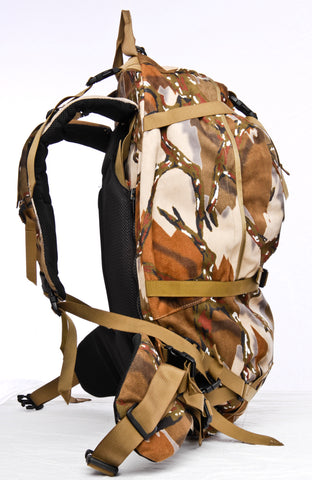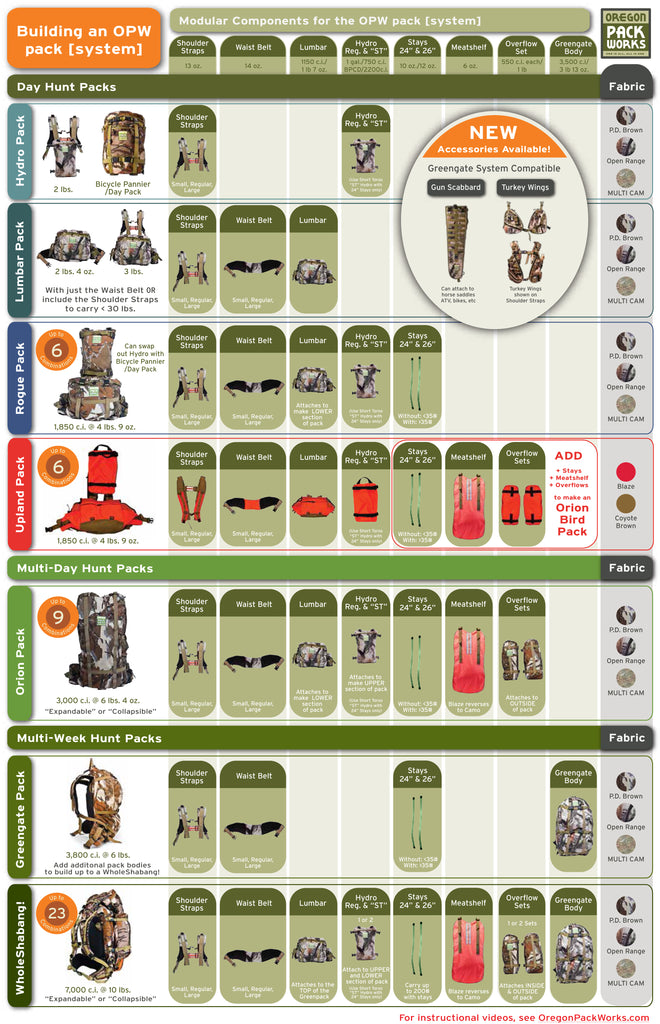Your Cart is Empty
Orders can take up to 3 weeks at times.

In the recent Western Hunting Journalreview, all of the backpacks in the review are capable hunting packs-Yes!
It is difficult though to compare Apples to Oranges; all fruit yes, but different fruit. The WholeShabang! that was tested, is a significantly DIFFERENT pack than those next to it. First, the WS! weighs 9# 9 ounces. The Orion weighs, 6# 6 ounces.
If the Orion was the pack of choice in the review, it would have limitations against larger cubic inch packs. Conversely, smaller packs couldn't perform the same against our WholeShabang!
We have strongly fought the single-function, one dimensional, top-loading back pack. I had nine of those packs when I sought a better way. Now, I have whatever I need at my finger tips for each trip--from a simple two pound Lumbar pack to an expedition-sized pack.
We opted to go a different direction. One without limits. Where YOU could create what YOU wanted on your back dictated by the hunt, each and every outing. Whether a Shed hunt, Bighorn Sheep, Turkey, Bear, Moose or other hunt.
Assemble what pack configuration you need on your suspension. Tailor it to fit your needs, now or in the field. Never have too small or too large of a pack-on-your-back again!
Let's look at the WholeShabang! in pictures. Whether you start with a large pack body, or small, the results can be the same-whichever direction you prefer.The result is, you never go without the pack you need--whether large or small.
If you start with a WholeShabang!, then removing parts is how to go from Expediton-size down to your hunting pack of choice. Let's start with our largest pack-body and build up: Greengate Body is the base pack, at 3,800 c.i.

Now, add components; Lumbar on top, Over Flow's on the sides; Hydro on the back--high or low position, and lastly the meat shelf. That means that an Orion Pack is attached to your Greengate to create the WholeShabang!
Once at your backcountry camp, disassemble, and create what YOU want to hunt in.
A Lumbar (no frame):

A Rogue (minimal pack w/frame):

or the Orion, what I hunt with:

Blaze-side exposed on the meat shelf,

Orion, above without meat shelf, Over Flow bags exposed.
 Fully loaded and expanded...
Fully loaded and expanded...
Here, with 105# of Bone-in Blacktail...one-time pack out and overloaded at 125#.

A 80# water haul...
Backpack choice for hunting is as personal as one's choice of Boot, Bow or Binocular. Of course people stand by their brands (Brand Loyalty) for very well thought-out reasons.
18 years ago, I had various sized and shaped hunting packs. From the nine backpacks I owned then, I could never decide what to hunt in; between the small quiet day pack, medium-sized pack or the large meat-hauler, so I found myself taking TWO packs on my back at times.
Finally, in 2004--six years before Oregon Pack Works launched as a business; the year I killed my first Trad-Bow Mule Deer--1,000 feet below camp where my meat-hauler was, I had to find a better way, as my day pack couldn't even carry all the cuts.
Once to the top of the climb out of the deep canyon, on my way to hang the first load of cuts and two deer quarters, my brain was feeling fresh, as it was still only 10:30 at night. A light rain fell, cooling me for the second 1,000 foot climb with the remaining quarters and cuts.
I crawled into my Bivy-sack (the last time I used that thing!) soaked and cold. It took a bit to fall asleep, but the tired satisfaction of hard work was warming me.
The large pack was tough to hunt in, but great to haul-in camp, haul meat and haul camp out. The smaller pack was incapable of meat-hauling once an animal was down, and out miles (7-1/2 miles from a base camp)--at least 12 hours from a cooler--wasting a trip without moving meat to a cool place just wasn't in the cards.
I was awake with the dawn and prepped my small camp to exit in three trips. Halfway down to my river camp, some horse packers had a scale sitting out--71# for my first load. After hanging the largest and slowest to-cool quarters (Hams), I replenished my electrolytes with a quart of Gatorade and headed for the top again.
Halfway through my second trip down to the River, I borrowed the packer scale again--71# for my second load--with one more load to go to get camp and the end will be mid-day tomorrow.

I met the two hunters camped with two horses and a mule my last trip down from the top. Bert and Travis were from White City, Oregon and commented that, "I'd been lucky". I stated, I had, then said, "Took my first Trad-Bow kill and I would have the horns on for the final trip down with my remaining camp".
They didn't offer the use of their horses or mule, so as I came back down the next morning with camp and antlers, they were both excited for me.
Upon return, my fire-fighter Co-workers liked the pack I had built for my hunts. A few chimed in and asked, "Can you make me one of those"? Which we did build, 12 Beta-test packs (2009), with four of us hauling meat that year.
Thus, our design had it's unwritten rules: Do both well; haul meat and be a compressible and expandable day-pack. Plus, other variations in between, and beyond that!
Well, as many of you know, we don't have to compress to be a hunting-day-pack, and our packs easily expand to shed-antler hauler or meat-hauler size.
The Epihany, back in 2004 resulted in an interchangeable suspension. It ran through my brain until arriving home and took us to where we are today--The One is All Suspension.
And, as we had created an interchangeable suspension the modular pack components added to the combinations possible by our design.
Today, with over thirty changes to the original design, but ONE design that will always be COMPATIBLE between generations, for years in the future, we continue to create new ideas, products and more combinations for you to utilize.
Comments will be approved before showing up.


A. Chest
B. Sleeve
C. Waist
D. Inseam